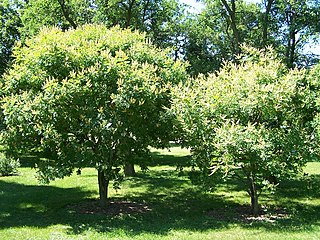
Actinidia is a genus of woody and, with a few exceptions, dioecious plants native to temperate eastern Asia, occurring throughout most of China, Taiwan, Korea, and Japan, and extending north to southern areas of Russian Far East and south into Indochina. The genus includes shrubs growing to 6 metres tall, and vigorous, strong-growing vines, growing up to 30 m (100 ft) in tree canopies. They mostly tolerate temperatures down to around −15 °C (5 °F), and some are much hardier.

Hydrangea, commonly named the hortensia, is a genus of more than 70 species of flowering plants native to Asia and the Americas. By far the greatest species diversity is in eastern Asia, notably China, Korea, and Japan. Most are shrubs 1–3 m tall, but some are small trees, and others lianas reaching up to 30 m (100 ft) by climbing up trees. They can be either deciduous or evergreen, though the widely cultivated temperate species are all deciduous.

Cornus kousa is a small deciduous tree 8–12 m (26–39 ft) tall, in the flowering plant family Cornaceae. Common names include kousa, kousa dogwood, Chinese dogwood, Korean dogwood, and Japanese dogwood. Synonyms are Benthamia kousa and Cynoxylon kousa. It is a plant native to East Asia including Korea, China and Japan. Widely cultivated as an ornamental, it is naturalized in New York State.

Aletris, the colicroot, colicweed, crow corn, or unicorn root, is a genus of flowering plants in the family Nartheciaceae, native to North America and to eastern and southeastern Asia, especially China. It was used as a component in Lydia Pinkham's original Vegetable Compound.

Maackia is a genus of flowering plants in the legume family, Fabaceae. There are 9 species, all native to eastern Asia, from China and Taiwan through Korea, Japan, and the Russian Far East. Six species are endemic to China. The generic name honors the botanist Richard Maack.

Astilbe chinensis, commonly known as false goat's beard, tall false-buck's-beard or Chinese astilbe, is a plant in the saxifrage family, Saxifragaceae. It is a perennial herb that grows near shaded streams and rivers. It is also commonly grown in shade gardens.

Hydrangea bretschneideri is a species of flowering plant in the family Hydrangeaceae, native to most of China.
Hydrangea chungii is a species of flowering plant in the family Hydrangeaceae, native to southeast China. It was formally described by Alfred Rehder in 1931. It is a small shrub that grows up to 0.7 m (2.3 ft) tall.
Hydrangea davidii is a species of flowering plant in the family Hydrangeaceae, native to China. It is a shrub that grows 1–3 m (3.3–9.8 ft) tall. Its habitats include mountain slopes, valleys and mixed forests.
Hydrangea gracilis is a species of flowering plant in the family Hydrangeaceae, native to China. It was formally described by W.T. Wang and M.X. Nie in 1981. It is a shrub that grows up to 1 metre tall.
Hydrangea hypoglauca is a species of flowering plant in the family Hydrangeaceae, native to China. It is a shrub that grows 1–3 m (3.3–9.8 ft) tall. Its habitats include mountain slopes, mountain tops, valleys and dense to sparse forests.
Hydrangea linkweiensis is a species of flowering plant in the family Hydrangeaceae, native to China. It grows up to 3 metres tall.

Hydrangea xanthoneura is a species of flowering plant in the family Hydrangeaceae, native to China.
Hydrangea zhewanensis is a species of flowering plant in the family Hydrangeaceae, native to China.

Sphagneticola calendulacea is a perennial herb in the genus Sphagneticola. It is found in China, India, Indonesia, Japan, Myanmar, Philippines, Sri Lanka, Thailand, Taiwan,Bangladesh and Vietnam. Tolerant to drought, humidity and barren environment, S. calendulacea is a common herbaceous plant in China and Taiwan. S. calendulacea produces wedelolactone and demethylwedelolactone.

Abelia chinensis, commonly known as Chinese abelia, is a species of flowering plant in the honeysuckle family Caprifoliaceae. It is a semi-evergreen, densely branched shrub with dark green foliage.

Allium lineare is a Eurasian species of wild onions with a wide range extending from France to Mongolia.

Najas gracillima, the slender waternymph, is a submerged species of aquatic plant in the Hydrocharitaceae family. found in lakes and streams. It is native to China, Russian Far East, Japan, Korea, Taiwan, Iran, Alberta, Ontario, Newfoundland, Nova Scotia, New Brunswick, the eastern United States. It is also considered introduced and naturalized in France, Spain, Italy and California.

Hypericum patulum, known as goldencup St. John's wort or yellow mosqueta, is a species of flowering plant in Hypericumsect. Ascyreia.
Actinidia callosa, the Himalayan kiwi vine, is a species of flowering plant in the Chinese gooseberry family Actinidiaceae. It is native to the Himalayas, central and southern China, Taiwan, Myanmar, Vietnam, Peninsular Malaysia, and Sumatra.













